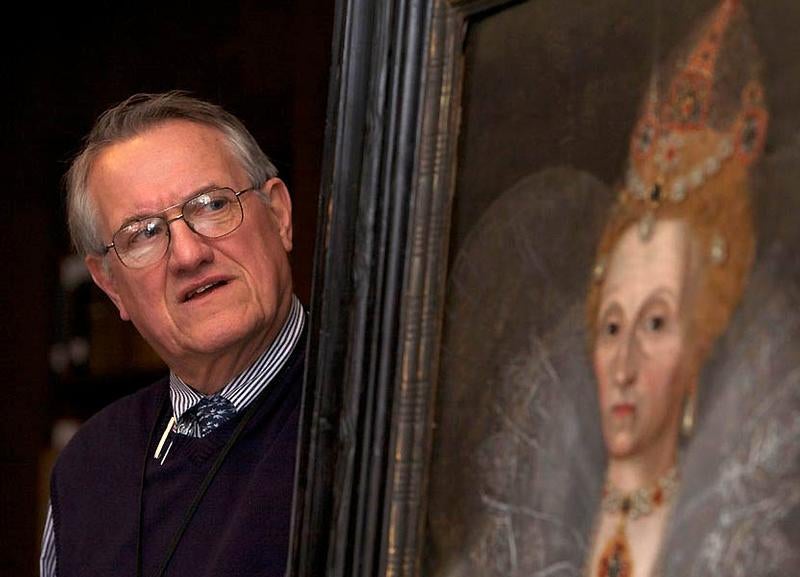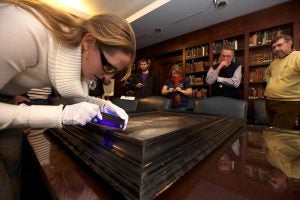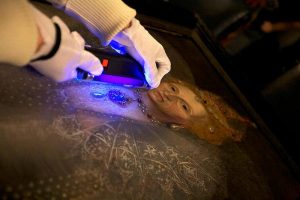Queen Elizabeth I portrait at ECU for analysis, authentication

Larry Tise, the Wilbur & Orville Wright Distinguished Professor of History at ECU, looks at the portrait of Queen Elizabeth I as it is delivered to ECU, where it will be months of extensive study.
GREENVILLE, NC — For almost 50 years, a portrait of Queen Elizabeth I hung in the Elizabeth Gardens gatehouse on Roanoke Island. Thousands of visitors passed by it. Volunteers worked near it for years.
Most of the tourists probably didn’t give the painting a second look. A few asked if they could buy it – the offers range from $50 to several hundred dollars. No, the volunteers would reply.
What neither group realized years ago was the painting is a 1592 portrait of Queen Elizabeth, when the monarch would have been about 60 years old. It is one of only a few portraits of the queen in her later life.
How a painting attributed to the studio of Marcus Gheeraerts the Younger ended up in Dare County is almost as big of a question as “Is it real?”
Answering the authenticity question has landed on the shoulders of a group of experts at East Carolina University, led by Larry Tise and Susanne Grieve, both of the Department of History.
Tise is the Wilbur and Orville Wright Distinguished Professor of History at ECU and teaches in the Thomas Harriot College of Arts and Sciences. His work two years ago authenticating a table owned by the Wright Brothers earned him even more name recognition on the Outer Banks, plus he loves North Carolina historical mystery.
Grieve specializes in conservation work, especially in waterlogged items, for the Maritime Studies program in the Department of History.
In February, the portrait arrived at ECU for the months-long process of analysis to begin.
As Joyner Library Assistant Director for Special Collections Maury York and former Elizabethan Gardens Executive Director Horace Whitfield unwrapped the portrait from its protective blankets, Tise and Grieve were excited at the prospects the project held.
Tise said, “Many years ago I visited the gardens, went into the gatehouse and noticed the portrait. And just a few years ago, I remember going to the Elizabethan Gardens and Horace (Whitfield) took Alan White and myself on a tour and he said Mrs. Charles Cannon hung it there. I didn’t think this day would ever happen.”
Whitfield replied, “I knew it would as soon as we started talking.”
In 2008, ECU hosted a conference focusing on Sir Walter Raleigh. As part of the event, the group took a field trip to Manteo to view the painting and discuss it.
“We had a session at the Elizabethan Gardens so Anna Riehl, then an assistant professor of English at Auburn University, could examine the portrait,” Tise said. “The historian said, oh my gosh, this could be really important.”
The portrait is believed to be from the studio of painter Marcus Gheeraerts the Younger, Tise said. That studio produced the Ditchley Portrait of Queen Elizabeth I, circa 1592, which hangs in the National Portrait Gallery in London.
The daughter of Henry VIII and Anne Boleyn, Elizabeth came to the throne, at the age of 25, on the death of her half-sister Mary I in 1558 and reigned until 1603.
According to a 2008 Virginian Pilot newspaper article on Riehl’s findings, she believes that Queen Elizabeth never saw this painting since it’s “definitely unflattering realism.” The queen was known to destroy paintings she found unflattering. About 150 paintings of Queen Elizabeth are known to have been painted in her lifetime, Riehl said. Of those, about a dozen are in the United States.
Riehl’s pronouncement peaked Tise’s curiosity even more to take the portrait out of its massive frame so experts could examine it fully.
For the Elizabethan Gardens board and staff, it has become a question of knowing exactly what the Elizabethan Gardens owns and protecting it. The earliest known full-length image of the queen sold at Sotheby’s in London in November 2007 for more than $5.3 million, according to the Virginian Pilot article.
After the Elizabethan Gardens staff learned its current value, the portrait went into a climate-controlled archival facility.
Because there is limited documentation about its purchase, nothing is known about the painting before it was purchased in the 1950s by Mrs. Charles Cannon, who directed that it be hung in the gatehouse when it was completed in 1960.
Cannon was one of the gardens’ first benefactors and bought the painting at an art house in New York, Whitfield said. At that time, the Garden Club of North Carolina was 50,000 women strong and had the funds to furnish the Elizabethan Gardens with period pieces or high-end furniture reproductions. The gardens opened in 1960 as a tribute to the 1584-87 English voyagers who came to Roanoke Island.
The portrait hung in the gatehouse for decades, exposed to seasonal changes in humidity and temperatures, Whitfield said, not the ideal conditions for a painting.
As Grieve hovered over the painting, wearing magnifying glasses, her excitement at what she was seeing was clear. “Oh wow! She is gorgeous!”
“We can get just as much information from the frame as the painting,” she said as she passed an ultraviolet light over the frame and painting to look for any traces of modern paint or varnish. “This surface is unbelievable. It’s appears to be the original varnish still intact,” she said.
The ultraviolet light “excites the pigments,” she said, and can show if modern restoration or paints have been used on the portrait. Modern repairs will fluoresce brightly under ultraviolet light.
Whitfield said records show that the painting was cleaned in the 1950s. Grieve said it was nicely done job since it doesn’t seem to have adversely affected the portrait.
She paused over the queen’s necklace. “This pendant is really interesting. The decorations and jewels are sometimes painted over as the fashion changes,” Grieve said.
Next the painting will be X-rayed to determine how to take the painting out of the frame without damaging it. At some point, reinforcements were added to the back of the frame. After it’s out of the frame, both will be analyzed. That work is expected to begin later this month.
Tise said when he first saw the portrait and later heard the art professor’s opinion of it, he began planning on how it could be analyzed and authenticated.
“I had a secret desire that ECU would be the place to do further research on the portrait,” he said. “Our purpose from ECU’s point of view is to provide service to eastern North Carolina organizations and to examine the artifact.
“We haven’t had an opportunity until this project came along to bring all conservators and historians together like this,” he said.
“We’ll look through this portrait to see what’s in there. We don’t know what we’ll find, but we’ll look,” he said. “We will not do anything invasive; we won’t be scratching paint samples.”
The portrait is painted on a wood panel, which Grieve guesses is oak, and a seam can be seen where two boards are joined. “The wood reacts changes in humidity which can be very damaging. We’ll be able to take a look at the wood when we remove it from the frame,” she said.
The massive black frame has a few nicks and dings into its layers of paint that will be helpful as Grieve and the others try to unlock some of the painting’s secrets.
“I think we’re going to be able to get a lot of information from the frame. The damage to the frame allows us to take a peak at how many paint layers there are. I can’t wait to get this backing off,” Grieve said.
Also, Grieve plans to identify the composition of the pigments, which will help to date the painting.
The group has a deadline to end their work – Aug. 18, Virginia Dare’s birthday and the 60th anniversary of the inception of the Elizabethan Gardens.
The portrait of Queen Elizabeth I will be back on Roanoke Island for the festivities but not hanging in its former location in the gatehouse gift shop. The portrait will be displayed 9 a.m. to 6 p.m. Aug. 19 in the Reception Hall at the Elizabethan Gardens.
And then it will be returned to its climate-controlled archival facility.

Susanne Grieve of the ECU Department of History examines the portrait for clues about its history, looking for any signs of restoration.

Susanne Grieve passes an ultraviolet light over the painting and the frame to look for traces of modern paint or varnish.